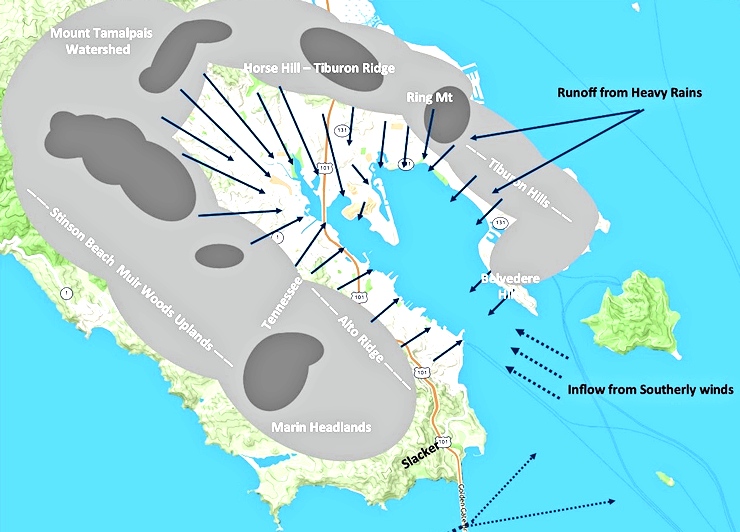
This is the second installment of a research paper on the microclimates of Richardson Bay by Yellow Ferry Resident Richard Pavek.
An inch of rain falling on the Bay raises the high and low tides an inch more than predicted. But an inch of rain falling on the surrounding area—which is over eleven times the area of the Bay—will, when the ground is thoroughly saturated, drain rapidly into the Bay, raising the tides as much as eleven inches above the predicted levels.
The accumulated water in Richardson Bay subsides slowly—the outflow travels towards the ocean at around four miles per hour, slower if there is a southwesterly wind.
High southwesterly winds blowing up San Francisco Bay during and after rainstorms will push the San Francisco Bay water into Richardson Bay, raising the tides even further. This wind-blown water can add another half-inch or more to the tidal levels.
Despite what some presume, King Tides are not a factor in our flooded parking lots and streets, as the King Tides barely raise the bay level an inch or two! There are no massive waves or breakers here; there is no surfing in Richardson Bay!
“King Tide” is a colloquial term for an exceptionally high tide, such as a Perigean Spring Tide (Perigean is the point in the Moon’s orbit when it is closest to Earth). “King Tide” is not a scientific term, nor is it used in a scientific context. Use of the word “King Tide” originated in Australia, New Zealand, and other Pacific nations by surfers to refer to an exceptionally high tide that occurs only a few times a year at a Perigean. According to Wikipedia, “this usually adds only a couple of inches to normal spring tides.” The term is not used at the Sausalito Corps of Engineers Bay Model facility.
The drenching rains of winter pour down the surrounding hills, raising the level of Richardson Bay. So, when El Niño is on the loose, the rains are pouring down, and you are worried about flooding, or there is a danger of overnight storms filling your parking lot and the nearby roads, best you move your car to higher ground. Seawater rusts cars quickly!
Ed. Note: Tides of 6.2′ or higher are predicted from November 22-28, and some rain is forecast during that period. To check the times of these tides, go to the interactive tide chart on this page and click on the ‘Day+’ sign in the upper left corner of the chart to advance a day at a time.